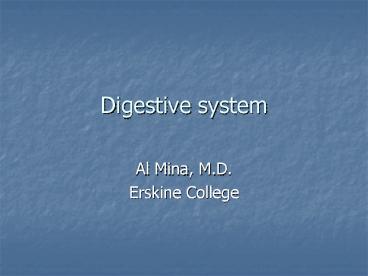Digestive system PowerPoint PPT Presentation
1 / 39
Title: Digestive system
1
Digestive system
- Al Mina, M.D.
- Erskine College
2
Modified from
- Powerpoint Presentation for BG210-211 made by
- Dr. Nora Espinoza, Ph. D.
- Which was
3
Modified from a PowerPoint Presentation made
to accompanyHoles Human Anatomy and
Physiology, 11/e byShier,
Butler, and LewisMcGraw-Hill - publisher
4
Digestion
- Breakdown of foods into absorbable form
- Mechanical
- chemical
5
Digestive system
- Alimentary canal
- Structures that food passes through directly
- Accessory organs
- Secrete substances into canal
6
(No Transcript)
7
Alimentary canal
- 8 meters long
- Wall similar layers throughout (in different
forms) - Lumen
- Mucosa
- Submucosa
- Muscular
- serosal
8
- Mucosa
- Epithelium, connective tissue
- Mucous secreting glands
- Function protection, secretion, absorption
- Submucosa
- Loose connective tissue, vessels, nerves, lymph
- Nourishment, removes absorbed substances
9
- Muscular layer
- Two layers of smooth muscle
- Circular narrows lumen
- Longitudinal shortens tube
- Movement of tube and contents
- Serosa
- Visceral peritoneum
- Covers, lubricates tube
10
(No Transcript)
11
Movement
- Mixing movement
- Rhythmic movement in small areas
- Example stomach
- Propelling movement
- Contraction relaxation downstream
- Wavelike contraction - peristalsis
12
innervation
- Primarily muscular
- Parasympathetic increase activity
- Sympathetic decreases
- Submucosal plexus controls secretions
- Myenteric plexus motility
- Also has sensory neurons
13
(No Transcript)
14
Mouth
- Receives food
- Begins digestion
- mastication
15
Cheeks
- Lateral walls of mouth
- Muscles for chewing and expression
16
Lips
- Sense temperature and texture of food
17
Tongue
- Muscular organ
- Covered by mucous membrane
- Connected by lingual frenulum to floor of mouth
- Helps in mixing food, moves to back of mouth for
swallowing - Papillae friction, taste
- Connects to hyoid bone
18
Palate
- Roof of oral cavity
- Hard palate anterior portion bone
- Soft palate posterior muscular
- During swallowing, soft palate elevates to keep
food out of nasal cavity - Palatine tonsils lymph tissue
19
Teeth
- Hardest structures in body
- Primary set 20 teeth
- Shed when roots resorbed
- Secondary -4 sets of 8
- 2 incisors
- Canine
- 2 bicuspids (premolars)
- 3 molars
20
Teeth
Figure 17.9
21
Function
- Begin mechanical digestion
- Allows digestive enzymes to work more effectively
22
Teeth
Figure 17.10
23
- Crown above gumline
- Root below
- Enamel hardened calcium salts irreplaceable
- Dentin living tissue
- Central cavity contains vessels, nerves
- Root canals entry points for vessels
24
- Cementum bonelike material enclosing root
- Periodontal ligament connects tooth to jaw
25
Salivary glands
- Secrete saliva
- Moistens food
- Dissolves food for taste
- Begins digestion
- Contains amylase splits complex carbs into
disaccharides - Cleans teeth
26
Contd
- Innervated by para/sympathetic
- Can activate at sight/smell/thought of food
27
Salivary glands
- Parotid largest
- Cheek
- Secretes mosly amylase
- Submandibular
- Inside lower jaw
- Mixed amylase/mucous (lubricant)
- Sublingual
- Below tongue
- Mostly mucous secretions
28
Figure 17.11
29
Pharynx
- Important for swallowing
30
Palate
Figure 17.7
31
Swallowing
Figure 17.14
32
(No Transcript)
33
Swallowing stage 2
- Soft palate elevates
- Larynx/hyoid bone elevate, epiglottis closes
- Tongue presses upward
- Longitudinal muscles contract, pulling pharynx
upward - Lower constrictor muscles relax
- Higher constrictor muscles contract, propelling
food into esophagus
34
Also step 2
35
Step 3
36
Figure 17.15
37
esophagus
- Straight 25 cm tube
- Propels food through thoracic cavity to stomach
- Posterior to trachea
- Goes through diaphragm at esophageal hiatus to
reach stomach. - Secretions mucous (no digestion)
38
(No Transcript)
39
Contd
- Lower esophageal sphincter (cardiac sphincter)
prevents food in stomach from regurgitating into
esophagus - Weakness of this sphincter can lead to reflux of
stomach acid into esophagus heartburn

